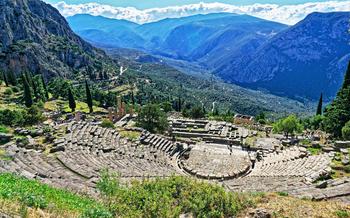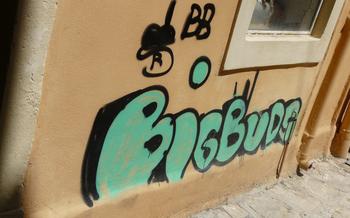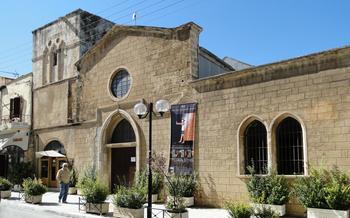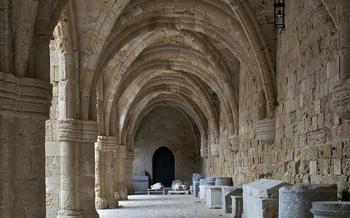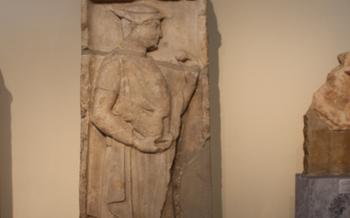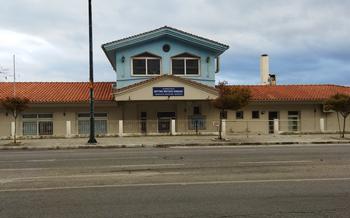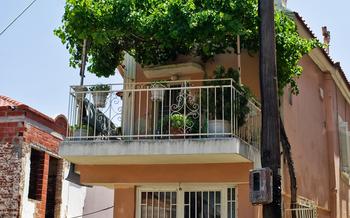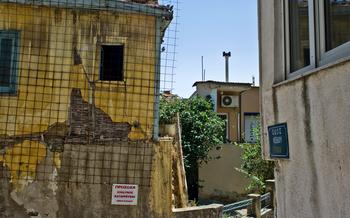
The Archaeological Museum of Kavala
- The Archaeological Museum of Kavala: A Journey Through History
- Exhibits from the Ancient City of Neapolis:
- Mosaics and Frescoes
- Inscriptions and Papyri
- Coins and Jewelry
- Ceramics and Pottery
- Tools and Weapons
- Sculptures and Statuettes
- Interactive Exhibits and Multimedia Displays
- Educational Programs and Workshops
- Accessibility and Visitor Services
- Museum Shop and Souvenirs
- Events and Exhibitions
- Insider Tip:
The Archaeological Museum of Kavala: A Journey Through History
Housed in a stately 19th-century tobacco warehouse, the Archaeological Museum of Kavala takes visitors on a captivating journey through the rich history and cultural heritage of the region. Established in 1934, the museum showcases a remarkable collection of artifacts unearthed from the ancient city of Neapolis, shedding light on the city's vibrant past and its significant role in the Hellenistic, Roman, and Byzantine periods. Located in the heart of Kavala's Old Town, the museum's imposing neoclassical facade hints at the treasures that await visitors within its walls. Among the highlights of the collection are the stunning statue of the goddess Artemis, a masterpiece of ancient Greek sculpture, and a wealth of mosaics, frescoes, inscriptions, coins, jewelry, pottery, tools, weapons, sculptures, and statuettes that offer a comprehensive glimpse into the daily lives, artistic traditions, and economic activities of ancient Neapolitans.
Exhibits from the Ancient City of Neapolis:
The Archaeological Museum of Kavala houses a remarkable collection of artifacts excavated from the ancient city of Neapolis, which flourished during the Hellenistic and Roman periods. These artifacts provide a glimpse into the daily lives, cultural traditions, and economic activities of the Neapolitans.
Among the most notable exhibits are stunning marble sculptures, intricate mosaics, and well-preserved pottery. The statues depict gods, goddesses, and mythological figures, showcasing the Neapolitans' deep religious beliefs and artistic prowess. The mosaics, with their vibrant colors and detailed designs, adorn the floors of ancient villas and public buildings, offering insights into the city's architectural grandeur.
The pottery collection, with its diverse shapes and decorative motifs, sheds light on the Neapolitans' culinary practices, trade networks, and domestic life. Amphoras, used for storing and transporting wine and olive oil, reveal the city's involvement in agricultural trade, while household ceramics provide glimpses into the daily routines of Neapolitan families.
These exhibits, collectively, offer a comprehensive narrative of Neapolis's rich past, showcasing the city's cultural achievements, economic prosperity, and its enduring legacy as a center of Hellenistic and Roman civilization.
Mosaics and Frescoes
The Archaeological Museum of Kavala houses an impressive collection of mosaics and frescoes that provide a glimpse into the artistic heritage of ancient Neapolis. These intricate and colorful artworks adorn the walls and floors of the museum, showcasing the skill and artistry of Neapolitan craftsmen.
The mosaics depict a wide range of subjects, from mythological scenes to everyday life. One particularly notable mosaic depicts a chariot race, complete with horses, chariots, and cheering spectators. Another mosaic features a hunting scene, with hunters on horseback pursuing a deer. The mosaics also include geometric patterns and floral motifs, demonstrating the versatility of this art form.
The frescoes, on the other hand, are painted directly onto the walls of the museum. They depict religious scenes, portraits, and landscapes. One of the most famous frescoes is a depiction of the Virgin Mary with the infant Jesus. The frescoes are notable for their vibrant colors and expressive style, which bring the stories they depict to life.
Together, the mosaics and frescoes offer a vivid portrayal of the artistic traditions and cultural influences that shaped ancient Neapolis. They provide a glimpse into the everyday lives of the city's inhabitants, their beliefs, and their artistic sensibilities.
Inscriptions and Papyri
The Archaeological Museum of Kavala also houses a collection of inscriptions and papyri that provide valuable insights into the history and administration of ancient Neapolis. These inscriptions, written in various languages and scripts, include decrees, laws, contracts, and other official documents. They shed light on the political, economic, and social organization of the city, as well as its relationship with neighboring regions and the wider Hellenistic world.
The papyri, which are preserved under controlled conditions due to their fragile nature, offer a glimpse into the everyday lives of ordinary Neapolitans. They include personal letters, receipts, and other documents that reveal information about family relationships, trade, and religious practices. By studying these inscriptions and papyri, researchers can reconstruct the social and cultural fabric of ancient Neapolis and gain a deeper understanding of the daily lives of its inhabitants.
Coins and Jewelry
The Archaeological Museum of Kavala houses an impressive collection of coins and jewelry that provide valuable insights into the economic and cultural life of ancient Neapolis. The coins, minted in various metals such as silver, bronze, and gold, showcase a diverse array of designs and symbols. These designs often depict local deities, rulers, or mythological scenes, offering a glimpse into the religious beliefs and political landscape of the city.
The jewelry collection, crafted from gold, silver, and semi-precious stones, showcases the exquisite craftsmanship and artistry of ancient Neapolitan goldsmiths. The intricate designs, featuring delicate filigree work, gemstones, and enamel, reflect the high level of skill and creativity possessed by these artisans. These adornments, worn by both men and women, held significant social and cultural significance, often indicating wealth, status, or personal style.
Ceramics and Pottery
The Archaeological Museum of Kavala houses a remarkable collection of ceramics and pottery that provides a glimpse into the everyday lives of the ancient Neapolitans. These artifacts showcase the artistry, craftsmanship, and domestic practices of the region's inhabitants.
The collection features a wide range of ceramic objects, including amphorae, kraters, jugs, cups, plates, and cooking pots. These vessels were used for various purposes, from storing and transporting liquids and grains to serving food and beverages. The intricate designs and decorations on the pottery reveal the artistic sensibilities of the ancient Neapolitan potters.
The techniques used to create these ceramics varied depending on the period and the intended use of the object. Some vessels were wheel-thrown, while others were hand-built. The potters employed various firing techniques to achieve different colors and textures.
The ceramics also provide valuable insights into the culinary and domestic practices of the ancient Neapolitans. The shapes and sizes of the vessels suggest how food was prepared, cooked, and served. Moreover, the presence of cooking pots and other kitchenware indicates the importance of food and communal dining in Neapolitan society.
Tools and Weapons
The Archaeological Museum of Kavala houses an impressive collection of tools and weapons that provide valuable insights into the technological advancements and craftsmanship of ancient Neapolis. These artifacts showcase the ingenuity and resourcefulness of the city's inhabitants, who crafted a wide range of objects to meet their daily needs and defend their community.
Among the most notable tools are agricultural implements such as hoes, sickles, and plowshares, which attest to the importance of farming in the region. There are also various tools used in construction, such as hammers, chisels, and saws, demonstrating the sophisticated building techniques employed by the Neapolitans.
The museum's collection also includes an array of weapons, including swords, spears, and arrowheads. These artifacts shed light on the military prowess of ancient Neapolis, which was strategically located on the crossroads of important trade routes and faced potential threats from both land and sea. The weapons on display showcase the skill and craftsmanship of the city's metalworkers, who produced high-quality arms for both defense and offense.
By examining these tools and weapons, visitors to the Archaeological Museum of Kavala gain a deeper understanding of the daily lives, technological achievements, and military practices of the ancient Neapolitans. These artifacts offer a glimpse into the challenges and triumphs of a vibrant and prosperous city that played a significant role in the history of the region.
Sculptures and Statuettes
The Archaeological Museum of Kavala also houses a remarkable collection of sculptures and statuettes that offer a glimpse into the artistic traditions of ancient Neapolis and the broader region. Crafted from various materials such as marble, limestone, and bronze, these works of art depict a wide range of subjects and themes.
Visitors can admire statues of gods and goddesses, heroes and athletes, as well as everyday people engaged in various activities. The sculptures showcase the skill and artistry of ancient craftsmen, with intricate details and lifelike expressions that bring the figures to life.
Among the highlights of the collection is a stunning marble statue of Aphrodite, the goddess of love and beauty. The statue portrays the goddess in a graceful and sensual pose, with her flowing hair and delicate features capturing the essence of her divine nature.
Another notable piece is a bronze statuette of Hermes, the messenger of the gods. The statuette depicts Hermes with his characteristic winged sandals and traveler's hat, emphasizing his role as a guide and protector of travelers.
These sculptures and statuettes provide valuable insights into the religious beliefs, mythology, and artistic traditions of ancient Neapolis. They offer a glimpse into the minds and hearts of the people who created and admired these works of art, allowing visitors to connect with the past in a tangible and meaningful way.
Interactive Exhibits and Multimedia Displays
The Archaeological Museum of Kavala enhances the visitor experience through a range of interactive exhibits and multimedia displays. These state-of-the-art installations bring the ancient world to life, providing visitors with a deeper understanding of Neapolis's history and culture.
Touchscreens and digital kiosks offer detailed information on the museum's artifacts and exhibits, allowing visitors to explore at their own pace and learn about the significance of each piece. Virtual reality experiences transport visitors back in time, immersing them in the sights and sounds of ancient Neapolis and allowing them to experience life as it was centuries ago.
3D models and animations provide a vivid representation of the city's landmarks, temples, and everyday objects, helping visitors to visualize the grandeur of Neapolis in its heyday. Interactive games and quizzes engage younger visitors, making learning about ancient history fun and interactive.
These interactive exhibits and multimedia displays complement the museum's traditional exhibits, creating a dynamic and engaging experience for visitors of all ages. They enhance the museum's educational mission, making ancient Neapolis accessible and relevant to a wider audience.
Educational Programs and Workshops
The Archaeological Museum of Kavala is committed to promoting a deeper understanding of ancient Neapolis and its legacy through a variety of educational programs and workshops. These programs are designed to engage visitors of all ages, from school children to adults, and provide a hands-on, immersive experience that brings the ancient world to life.
School groups can book guided tours of the museum, tailored to their specific curriculum needs. Museum educators lead interactive discussions and activities that encourage students to explore the exhibits, ask questions, and make connections to their own lives. Workshops on topics such as ancient Greek pottery, mosaics, and mythology allow students to get creative and express their understanding of the past in a tangible way.
The museum also offers workshops and lectures for adults, covering a wide range of topics related to ancient Neapolis and its culture. From in-depth explorations of specific artifacts to discussions on the latest archaeological discoveries, these programs provide opportunities for adults to learn, engage with experts, and expand their knowledge of the ancient world.
By offering educational programs and workshops, the Archaeological Museum of Kavala plays a vital role in fostering a greater appreciation for the region's rich cultural heritage and inspiring future generations of researchers and enthusiasts.
Accessibility and Visitor Services
The Archaeological Museum of Kavala is committed to providing a welcoming and accessible environment for all visitors. The museum is wheelchair accessible, with ramps and elevators throughout the building. Guided tours are available in multiple languages, including English, Greek, French, and German. Visitors can also rent audio guides in various languages for a more immersive and self-guided experience.
The museum offers a range of amenities and facilities to ensure a comfortable and enjoyable visit for all. There is a cloakroom where visitors can leave their belongings, as well as restrooms and a small café where they can grab a snack or a drink. The museum also has a well-stocked library and research center, open to the public for consultation and research.
Museum Shop and Souvenirs
The Archaeological Museum of Kavala features a well-stocked museum shop where visitors can purchase a variety of souvenirs and merchandise related to the museum's collection and exhibits. These items provide a tangible connection to the rich history of Neapolis and serve as a reminder of the museum's visit.
The museum shop offers a wide range of items, including replicas of ancient artifacts, books on archaeology and history, postcards, posters, and jewelry inspired by ancient Greek designs. Visitors can also find unique souvenirs such as handmade pottery, traditional Greek handicrafts, and local delicacies.
The proceeds from the museum shop play a vital role in supporting the museum's mission and activities. By purchasing souvenirs, visitors directly contribute to the preservation and promotion of Neapolis's cultural heritage. The museum uses the funds to acquire new artifacts, support educational programs, and maintain the museum's facilities.
Whether you're looking for a special gift, a unique souvenir, or a piece of history to take home, the Archaeological Museum of Kavala's museum shop is worth a visit. It offers a diverse selection of items that cater to different tastes and budgets, ensuring that every visitor can find something to cherish.
Events and Exhibitions
The Archaeological Museum of Kavala regularly hosts a variety of events and temporary exhibitions throughout the year. These events and exhibitions complement the museum's permanent collection and offer visitors an opportunity to engage with different aspects of ancient Neapolis's history and culture.
Past events have included lectures by renowned scholars, workshops on ancient Greek art and archaeology, and family-friendly activities such as storytelling sessions and crafts. Temporary exhibitions have showcased artifacts from other museums, explored specific themes related to ancient Neapolis, and highlighted new research and discoveries.
Visitors can stay informed about upcoming events and exhibitions by checking the museum's website, following its social media channels, or signing up for its email newsletter.
Insider Tip:
For an optimal visit to the Archaeological Museum of Kavala, plan your trip during the shoulder seasons (spring or autumn) to avoid the summer crowds and enjoy a more intimate experience.
-
Hidden Gems: Be sure to seek out the lesser-known exhibits, such as the collection of ancient coins and jewelry, which offer a fascinating glimpse into the economic and social life of ancient Neapolis.
-
Online Resources: The museum's official website provides detailed information about its exhibits, educational programs, and upcoming events.
-
Discounts and Promotions: The museum offers reduced admission fees for students, seniors, and families, making it an affordable and accessible destination for all.
